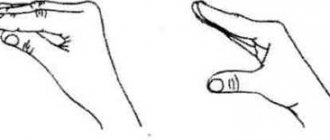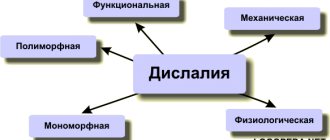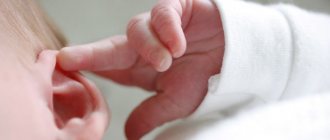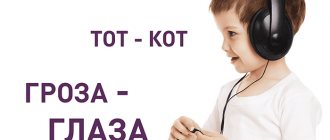Article:
Violation of sound pronunciation is a relatively common pathology among preschoolers and schoolchildren.
Its causes may include anomalies in the development and formation of the speech apparatus, an incorrect social environment and organic damage to the brain. Specific signs of the disease are the incorrect reproduction of sounds (absence, distortion, replacement, confusion). Diagnostic measures include methods for identifying the causes of sound pronunciation disorders. To improve the nature of sound reproduction, speech therapy sessions are carried out, and the main cause of speech impairment is treated.
The concept of sound pronunciation disorders, the development of speech function in a child
Sound pronunciation is (in speech therapy) the correct reproduction of speech sounds, thanks to the active work of the speech center and articulatory organs. The development of speech function in a child occurs gradually. The process of speech development can last throughout the preschool period. In the first year of life the sounds [a], [b], [p], [m], [g] appear; in the 2nd year the vowels [e], [u], [s], [o], [i], consonants [v], [t], [d], [k], [x], [l'], [s], [f]. When a child turns 3 years old, the following consonant sound units are formed: [w], [zh], [h], [sh'], [z]. The sounds [l], [r] are established by the age of 5-6 years.
In speech therapy, it is believed that the final development of a child’s speech function occurs only by the age of 5-7 years. During this age period, the patient can correctly reproduce all sound units of the language he speaks. If a child has a speech disorder after 5-7 years of age, then you should consult a doctor to find out the cause of speech dysfunction.
Case studies
A., 17 years old. She complained about the incorrect pronunciation of the sound “r”. She admitted that she has been embarrassed by her incorrect pronunciation since childhood and tries to structure her speech in such a way that there are no words with this sound in it. She really wants to enter a pedagogical university and therefore decided to turn to a speech therapist. 15 classes were conducted, sound was delivered, introduced into speech, and further recommendations were given on sound automation. Successfully entered the pedagogical university.
U., 35 years old. I complained about poor speech. In speech, the sound pronunciation of hissing and whistling sounds was impaired; all vowel sounds were pronounced as the same neutral nasal sound. Doctor’s diagnosis: “Consequences of neuro-infection. Dysarthria." 30 lessons were held. Speech function has been completely restored.
Etiological causes of speech dysfunction
The reproduction of sounds is disrupted due to damage to brain structures, improper development of the articulatory apparatus, as well as living in an uncomfortable social environment. These main reasons can greatly influence the formation of speech function. If a child lives with parents who pronounce sounds and words incorrectly or do not speak at all, then speech formation occurs incorrectly.
Speech often develops with a defect due to diseases of the brain. Damage to brain tissue can be caused by various injuries during childbirth or during the life of the child. Birth trauma occurs due to difficult and prolonged labor, as well as rapid labor. The brain can be damaged during prolonged hypoxia. Hypoxic damage is provoked by entanglement of the umbilical cord, prolonged labor, fetoplacental insufficiency, partial placental abruption, and increased uterine tone during gestation.
Etiology of abnormal development of the articulatory apparatus:
- High, flat or low palate - the patient is unable to position the tongue correctly to produce sounds.
- Plump lips, drooping or short lower lip – improper lip formation makes it difficult to articulate correctly during speech.
- Underdevelopment of the jaws (cleft lip, cleft lip even after surgical correction, malocclusion).
- Altered dentition – diastema (large gaps between teeth), double row of teeth and other pathologies.
Speech is also formed incorrectly when sounds are perceived incorrectly. Often, the development of speech function is strongly influenced by a somatic illness that worsens in a child before the age of 5-7 years.
To prevent improper development of speech function, you should plan your pregnancy and reduce the likelihood of infectious diseases during pregnancy. During the period of speech formation, it is important to develop the baby’s speech and correct sound pronunciation if there are disturbances in the reproduction of sounds.
Reasons for appearance
Polymorphic dyslalia can occur in children due to functional and mechanical disorders.
The main causes of the disease are:
- incorrect structure of the tongue;
- congenital pathologies, which include: cleft palate, cleft lip;
- improperly formed bite, uneven dentition or missing teeth;
- narrow or, conversely, high sky;
- underdevelopment of bones in the face;
- short bridle.
Dyslalia can also manifest itself due to functional changes:
- delay in speech development;
- genetic predisposition, when the jaw and articular apparatus are not properly developed;
- the child imitates the speech of other people;
- mental retardation;
- if family members speak different languages;
- lisping imitation of a child's speech;
- if phonemic hearing is poorly developed;
- poor health: weak immunity, frequent colds;
- learning foreign languages by children under 5 years old.
Polymorphic disorder of sound pronunciation is an ailment that can result from physiological problems. This phenomenon is common in preschool children and is associated with an immature articulatory apparatus.
Parents of children under 6 years old should not worry. But older children should be able to pronounce all sounds correctly; if there are problems, then you should seek help from a speech therapist.
Types of sound reproduction pathologies and clinical manifestations
A child can reproduce any sound incorrectly, but more often children pronounce whistling sounds poorly: ([s], [z], [ts]), hissing sounds ([w], [zh], [ch], [sh']), sonorants ( [p], [l]). These sounds have a complex structure and require sound pronunciation skills. Sound units that are easy to reproduce are less likely to be disrupted. These include − [m], [n], [t], [p]. These sound units appear at an early stage in the formation of speech function.
Types of sound reproduction disorders:
• absence of a sound unit; • sound change; • replacing one sound unit with another; • mixing sound units.
The absence of a sound unit manifests itself in the form of loss of sound in a word. It disappears at the beginning, in the middle or at the end of the word. Example: pocket - kaman, different - azny, Cupid - Amu.
Sound distortion is characterized by an altered pronunciation of a sound unit that does not correspond to the Russian phonetics system. This form of GSD (general speech impairment) includes several types of distortion:
- Change of sound unit [r]: velar or uvular [r].
- Distortion [s]: interdental [s].
- Modified [l]: bilabial [l].
In some patients, speech dysfunction is manifested by the replacement of sounds. Example: compote - tomkot, lip - oak, dusk - fumrak, cracker - fuharik, house - tom, hummocks - gochki, frame - ryama, lamp - lamp. Sound confusion is characterized by the patient confusing sound units with each other. Example: cap - boot, sleigh - shanochki. In this case, the child pronounces and distinguishes the sounds [s] and [sh] separately and correctly.
Types of dyslalia:
- Mechanical (pathologies of the articulatory apparatus, congenital diseases).
- Functional.
- Physiological (norm for patients under 5 years of age).
- Monomorphic sound pronunciation disorder is the incorrect reproduction of sound units belonging to the same group.
- Polymorphic sound pronunciation disorders are errors in the reproduction of more than four sound units belonging to different groups.
Symptoms
Polymorphic disorder of sound pronunciation is an acute form of the disease, manifested in the form of disturbances in normal human behavior. Symptoms appear constantly, increasing every day.
Observing a person with similar disorders, you may notice:
- unstable mood, changes several times a day;
- speech becomes devoid of any meaning;
- listening to the patient, you can notice that from time to time he is delusional;
- hallucinations, the patient says that someone or something is touching him, hears extraneous sounds and voices.
Often such disorders strongly resemble paranoid psychosis, depressive disorders, schizophrenia, and delusional disorder.
People with disabilities experience disorientation, but self-identification is preserved. The patient's concentration decreases. Partial darkening of consciousness is observed.
Symptoms of disturbances in the pronunciation of sounds can be represented by replacement, omission, mixing and distortion of sounds:
- Pass. If the sound drops out completely in any part of the word.
- Replacement. Persistent replacement of one of the sounds by another.
- Mixing. The child constantly confuses two correctly pronounced sounds in the stream of speech.
- Distortion. This is an irregular pronunciation, the use of sounds that are completely absent in the phonetics of the Russian language.
Types of dyslalia
| Pathology of other analyzers | Phonetic classification |
| · Articular-phonetic. · Acoustic-phonemic. · Articular-phonemic. | · Sigmatism (whistles and sibilants are pronounced incorrectly). · Impaired pronunciation of sonorant sound units. · Impaired creation of posterior lingual sound units. · Yottacism. · Change in voicing. · Incorrect reproduction of soft sounds. |
Diagnostic measures
The purpose of diagnostic measures is to identify the root cause of the disease, as well as to determine the type of sound pronunciation disorder. Diagnosis is carried out by a neurologist, pediatrician, speech therapist and other specialists, depending on the manifestations of the disease. If there are brain pathologies (hypoxia, cerebral palsy, head injuries, etc.), the child is first examined by a neurologist. If the patient has a disease of the auditory and visual analyzer, consultation with an otolaryngologist and ophthalmologist is required. The patient is referred to specialists by a pediatrician.
Depending on the pathology, the following are referred for examination:
- Blood, urine, biochemistry tests.
- Electroencephalogram.
- Magnetic resonance or computed tomography.
- Radiography.
- Otolaryngological examination and others.
At the end of the examination, the neurologist writes a conclusion and refers the child to a speech therapist. The speech therapist analyzes the causes of speech disorders, determines the symptoms and level of OHP and phonemic defect, and conducts a diagnostic speech therapy study. To do this, the child is given tasks to identify sounds pronounced incorrectly. At the end of the diagnostic measures, the speech therapist writes a conclusion (characteristics of pronunciation: which sounds are normal and which are defective) and draws up a plan for speech therapy sessions.
In order to identify sounds that are pronounced incorrectly, the child is shown cards with pictures of animals or objects. The child names what is shown in the picture. Using this simple technique, a speech therapist identifies which sound units are pronounced incorrectly. After determining the list of incorrect sounds, the speech therapist asks the patient to reproduce the sounds pronounced with an error (not as part of a word, but separately).
Therapeutic measures and correction of speech disorders
Therapeutic measures include therapy for the disease that caused the speech pathology, as well as correctional classes to correct the speech defect. In the presence of brain pathology (hypoxia, trauma, cerebral palsy), medications are prescribed that improve cerebral blood flow. Nootropic drugs are actively used: Pantogam, Cortexin and others. If a child’s speech function is inhibited by a severe chronic disease, then doctors try to reduce the severity of the disease and reduce the frequency of relapses.
In addition to treatment of the underlying disease, the child is prescribed regular speech therapy sessions. They can be group or individual. Group classes allow the patient to learn to listen and recognize errors in the words of other children. Classes are held both at home and in schools and kindergartens.
The main direction in the treatment of sound pronunciation disorders is an individual approach to each patient. Another aspect of correction is the use of the child’s compensatory capabilities. The correct selection of teaching materials is also of great importance during classes. The correction is aimed not only at correcting speech defects, but also at developing the intellectual abilities of children.
Corrective work methods
| Specific | Didactic |
| · Motor-kinesthetic. · Auditory-kinesthetic. | · Visibility. · Literature (with and without clarity). · Practice (games). |
The motor-kinesthetic form of training helps to establish a connection between the work of the articulatory apparatus and the sensation of it. The visual-kinesthetic technique allows you to visually remember how the functional articulatory apparatus works when pronouncing a particular sound, while helping with hand movements. Visualization involves the use of pictures, books, toys during learning so that the child can see what a sound or word looks like. The verbal method is characterized by the use of riddles, tongue twisters, words, sentences, and songs. Hands-on techniques combine learning and games. The game method of correction involves staging skits, fairy tales, and using intentional errors in words.
Classes include exercises for the articulatory apparatus, development of linguistic skills, breathing training and voice volume. Speech therapists also try to stimulate speech function with fine motor skills and coordination training. Massage movements of the fingers and facial muscles are actively carried out.
During training, the speech therapist tries to automate the sounds in the child’s speech by repeating syllables, words, sentences, and phrases. During the classes, the patient learns to speak correctly, retell and present what he has read or heard. For children who can write, a speech therapist teaches them how to spell words correctly. With severe dyslalia, the duration of correction is longer than with a normal sound pronunciation disorder. First, the patient is taught to distinguish incorrect sounds by ear, and then the defects are corrected. After the sounds are set, they are used in words, phrases, poems, and tongue twisters.
Timely diagnosis and speech correction helps restore speech function and prepare the child for school.
Sound pronunciation as an integral part of the formation of sound culture of speech of preschool children
Glazova Anastasia
Sound pronunciation as an integral part of the formation of sound culture of speech of preschool children
Research by linguists, psychologists, and teachers gives reason to believe that it is sound pronunciation that becomes the subject of the child’s attention (L. S. Vygotsky, D. B. Elkonin, N. Kh. Shvachkin, F. A. Sokhin, A. M. Shakhnarovich, E. I. Negnevitskaya ).
Sound pronunciation is the process of formation of speech sounds , carried out by the respiratory, voice-producing and sound-producing sections of the speech apparatus with the regulation of this process by the central nervous system.
Work on the formation of sound pronunciation should be based on consistent, step-by-step development of all sounds of the native language . You should start not with the most frequently violated sounds in children : [s], [w], [r], [l] and others, but with simple ones: [i], [f], [t], [s] and others , the articulation of which contains elements of the articulation of complex sounds . By consistently practicing clear pronunciation of all vowels and consonants , the child gradually masters the phonemic system of the language.
The sound structure of a language is studied by phonetics. Speech sounds, as a natural phenomenon, have an acoustic and articulatory side. For learning to speak, the articulatory side is important - a person’s production of speech sounds . Even more important is the functional side of speech sounds .
In accordance with the three aspects of speech sounds and other phonetic units, there are three aspects of phonetics, three phonetic disciplines - speech , speech physiology and phonology . Phonology studies speech sounds in terms of their functions and place in the language system.
Sounds are minimal , indivisible speech units, the way of existence of any language. They perform two functions:
bringing speech to auditory perception and distinguishing significant units of speech (morphemes, words, sentences)
.
In the sounds present in the words of a particular language, there is a group of basic basic sounds that can be pronounced in different ways (for example, the sound [r] people speaking Russian can pronounce grating or burring). But these differences are not significant from the point of view of the general system of language, because they do not lead to the formation of words or word forms . Sounds that are actually pronounced, but do not change the meaning or form of the word , are called phoneme shades.
A child mastering a language does not need to learn the differences in phoneme shades (there is no need to learn to pronounce [r] burry or graceful, but it is necessary to master those characteristics of sounds that are essential for communication in a given language, for example, softness and hardness of consonants.
The sound units of a language differ in their role in speech . Linear (arranged in a line, one after another)
sound units - sound , syllable, phrase - combine to form words. Only in a certain linear sequence does a combination of sounds become a word and acquire a certain meaning. Translinear sound units - stress , elements of intonation - characterize linear units and are a mandatory feature of children's sounding speech .
For preschoolers , first of all, the acquisition of linear sound units of speech ( sound and word pronunciation) , since the most difficult thing for them is the acquisition of articulation of individual sounds ([p], [l], [zh], [sh])
.
In the pedagogical and psychological literature, the process of mastering the sound structure of the Russian language by preschool has been studied and described quite fully in the works of A. N. Gvozdev, V. I. Beltyukov, D. B. Elkonin, M. E. Khvattsev, E. I. Radina .
According to D. B. Elkonin, the assimilation of the sound side of language begins from the moment when language becomes a means of communication, that is, when children begin to understand the words of adults addressed to them and pronounce the first independent words.
A child's early perception of words is based on rhythmic-melodic structure. The phonemic composition of the word is not perceived. N. X. Shvachkin called this stage “pre-phonemic development of speech ”
.
At 10–11 months. the word begins to serve as a means of communication and acquires the character of a linguistic means. of speech begins . F.I. Fradkina, in her experiments with seven- to eight-month-old children, replaced the words “okay-okay”
with the words
“captain-captain”
and received the same motor reactions to them.
N. Kh. Shvachkin, working with children from six months to one year, said “knock-knock”
and showed how to clap your hands.
Then he replaced “knock-knock”
with other combinations
of sounds ( “oo-oo”
,
“oo-oh”
).
The children continued to clap as if nothing had happened. N. Kh. Shvachkin established that the child is able to assimilate the sound side of speech in a certain sequence: first intonation (four to six months, then rhythm (six to twelve months)
and
the sound composition of the word (after one year)
.
In very early childhood, a child develops phonemic hearing . First, the baby learns to separate the sounds of the outside world (the creaking of a door, the sound of rain, the meowing of a cat, etc.)
from
the sounds of speech addressed to him . Striving to satisfy his needs, the child actively searches for sound designations of objects and phenomena of the surrounding world, greedily catching them from the lips of adults. However, the baby uses the means of language that he borrows from adults in a completely different way from them. The sounds of children's speech , as studies by E. I. Negnevitskaya and A. M. Shakhnarovich have shown, do not always fit into the adult language system.
They form their own, strictly ordered system. of sounds begins . First they differentiate (separate)
vowel
sounds from consonants . Further differentiation occurs within the group of consonants. Sonorant sounds are contrasted with noisy ones, dull ones with voiced ones, hard ones with soft ones, etc. Then the assimilation of socially assigned vowel sounds . L. S. Vygotsky wrote that first the child learns the purely external (
sound ) structure of the sign, which subsequently, in the process of operating with this sign, leads the child to its correct functional use.
During the experiments, young children who did not know what the word “whale”
were asked the question:
“What is bigger, a whale or a cat?”
The children gave the answer:
“Cat”
.
Then wooden figures of different sizes, called “Bim”
and
“Bom”,
.
The children were asked to put aside those figures that could be called “Bim”
, and those that could be called
“Bom”
.
As a result, the group called “Bim”
contained small figures, and the group called
“Bom”
included large ones.
It turned out that the vowel sound [i] was associated with something small in children, and the sound [o] with something big. This suggests that the child strives to find a literal reflection of certain properties of the object in the sound image of the word, which helps the child perceive the meaning of the word. Therefore, in the speech of children there is such a number of onomatopoeic and sound-depicting words that can appear in speech as an imitation of the sounds of the external world and serve to name objects and phenomena.
Children's mastery of speech sounds involves the joint activity of the auditory and speech motor analyzers. Acoustic images of speech , imprinted in the child's auditory memory, serve as the basis for the reproduction of sounds . By distinguishing pronounced sounds from the speech patterns of others , children improve their pronunciation. At the same time, at first, preschoolers learn not those sounds that they hear well, but those that are easier for them to pronounce. Of the vowel sounds, this is , as a rule, [a], then in the following sequence: first, children learn the sounds [i] and [u] , which are most different from each other in their articulation; then the sounds [e] and [o] appear in their speech . The greatest difficulty of the vowels is [s]. The order in which most children acquire consonants is as follows; labial sounds appear earlier than lingual sounds, hard labials - before soft labials, soft dental sounds before hard ones, stops - before fricatives, sibilants - before hissing ones.
Mastering a new type of articulatory movements brings to life a number of related sounds . When assimilated, a new sound some words , and in other words it still appears - (substitute)
.
Consonants, emphasized M.E. Khvattsev, are differentiated gradually through transitional sounds , for example, [s] passes into [sh] through the stages: [s] - [sъ] - [sh]. Children, when transitioning to the correct pronunciation of sounds , begin to use them in necessary and unnecessary cases, replacing with them even those sounds that themselves were substitutes for the first ones. Having mastered the pronunciation of the sound [w] (previously pronounced [s], the child says “shobaka”
,
“hair”
. M. E. Khvattsev explains this phenomenon of
“overuse”
or reverse replacement
of the sound by the fact that the newly acquired sound becomes a strong irritant for some time - dominant and, due to insufficient differentiation with the substitute, the latter is forced out even from the places it legally occupies.
Of great importance in pronunciation is the activity of the speech-motor apparatus, which is formed by preschool age , but has some features. One of the important prerequisites for the formation of speech is the child’s ability to imitate.
The tasks and content of teaching correct sound pronunciation are different at different age stages and are determined by the characteristics of the phonetic side of children's speech .
— By the age of three, children generally master sound pronunciation . However, their speech is still imperfect phonetically. It is characterized by a general softness ( “zyuk”
- beetle,
"syuba"
- fur coat,
"sing"
- no, etc.).
Replacement of back lingual sounds [k] , [g] with front lingual sounds - [t], [d] ( "tutolka"
instead of doll,
"dusi"
instead of geese, sometimes replacing voiced
sounds with voiceless ones . A significant part of three-year-old children do not know how to pronounce hissing sounds , most often replacing them with whistling ones ( "sapka"
,
"koska"
,
"zuk"
). There is an inability to pronounce
the sound [r] (omitting or replacing it, distortion of the sound [l] . Word pronunciation of younger preschoolers has its own characteristics, these include: abbreviation ( elision) of
words (
"tul"
instead of chair,
"vesiped"
instead of bicycle, permutations
(metathesis)
of words and
sounds ( "shaplya"
instead of hat,
"gofli"
instead of knee socks,
"korvik"
instead of rug); assimilation
(assimilation)
of one
sound to another ( “baba-ka”
instead of dog); merging
(contamination)
of two words into one (
“Mafeda”
instead of Maria Fedorovna); adding
sounds ( “reblyata”
,
“irzhavaya”
) and premature pronunciation of the subsequent
sound (anticipation)
.
-By the beginning of the fourth year of life, a child, under favorable upbringing conditions, masters the sound system of the language . A significant part of children master many sounds , word pronunciation improves, and the child’s speech becomes understandable to others. At the same time, there are still a number of imperfections in speech .
Note that in practice there is a widespread opinion that by the age of four, children’s pronunciation corresponds to age characteristics and program requirements; no major deviations from the norm are observed. Imperfections in the pronunciation of children of primary preschool age are usually considered as an age-related pattern that goes away on its own. Hence the underestimation of the need for training in the formation of the sound side of speech at this stage of individual differences. In fact, this is an apparent prosperity, because by the age of five, without special education, about 50% of children do not learn all the sounds of their native language . Mastering correct pronunciation in early preschool age is hampered by insufficient development of motor skills of the speech apparatus and phonemic hearing, and insufficient stability of neural connections. Children do not yet have a conscious attitude towards the imperfections of their pronunciation. At the same time, positive factors are greater imitation, children’s desire for playful actions, to imitate, and emotionality when perceiving sounds .
Mastering correct pronunciation in early preschool age is hampered by insufficient development of motor skills of the speech apparatus and phonemic hearing, and insufficient stability of neural connections. Children do not yet have a conscious attitude towards the imperfections of their pronunciation. At the same time, positive factors are greater imitation, children’s desire for playful actions, to imitate, and emotionality when perceiving sounds .
The characteristics of age also determine the content of training: overcoming the general softness of pronunciation, developing correct articulation and clear pronunciation of vowel sounds : [a], [u], [i], [o], [e]. Clarification and consolidation of the pronunciation of consonant sounds [l] , [b], [m], [t], [d], [i], [g], [f], in whistling sounds - [s] , [z], [ts]. Development in children of speech breathing, auditory attention and phonemic hearing, motor skills of the speech apparatus, preparation of the articulatory apparatus for the pronunciation of hissing and sonorous [l], [r] sounds . Children of middle preschool age master the pronunciation of all sounds of their native language , including sounds . The process of mastering sounds is complex ; it is characterized by instability of pronunciation, when a child pronounces sounds sound combination , and incorrectly in another. Typical are “reverse replacement”
of sounds or “reuse of
sound ” (instead of the old substitute, a newly acquired
sound is put - “shlon”
,
“shobaka”
).
-In the development of the sound side of speech in children in the fifth year, a kind of inconsistency . On the one hand, special sensitivity, special susceptibility to speech sounds , sufficiently developed phonemic hearing; on the other hand, insufficient development of the articulatory apparatus and complete indifference to articulation.
At this age, the child develops awareness of his pronunciation skills. Under the influence of training, a significant part of children begins to correctly evaluate the pronunciation of their comrades and their own. The kindergarten program aims to teach children to correctly pronounce all the sounds of their native language . However, some preschoolers aged five years have defects in the pronunciation of whistling, hissing and sonorant [r], [l] sounds . It is alarming that these deficiencies are present in a significant number of five-year-old children, despite the opportunities available to overcome them. of vowels and consonants , practicing the pronunciation of whistling, hissing and sonorant sounds . Work continues on diction, as well as the development of phonemic hearing and intonation expressiveness of speech .
The patterns of mastery of the sound side of speech make it possible to determine the priority lines for the formation of one or another mechanism at different age stages.
Correct sound pronunciation can be formed if children have sufficiently developed mobility and switchability of the “decans of the articulatory apparatus, speech breathing,” if they know how to control their voice. It is very important for the formation of correct sound pronunciation to have a well-developed speech ear, since it ensures self-control, and self-test always encourages improvement.
Violations of sound pronunciation can be caused by defects of the speech apparatus (cleft of the hard and soft palate, deviations in the structure of the dental system, short hypoglossal ligament, etc., insufficient mobility of the articulation organs, underdevelopment of phonemic hearing (inability to distinguish some sounds from others )
.
Decreased physical hearing, careless attitude towards one’s speech (inability to listen to oneself and others, assimilation of incorrect speech of others can also lead to pronunciation deficiencies.
Incorrect pronunciation of sounds is expressed in omissions of sound , replacement of one sound by another , distorted pronunciation of sound , it is especially important to start work on time with children in whom substitutions and distortions of sounds , since substitutions of sounds may later appear in written speech (replacing one letter with another, and distortedly pronounced and not corrected sounds in time will require great effort in the future (on the part of the speech therapist and the child himself)
and longer time to eliminate them.
So, the basis of the work on children’s assimilation of the phonemic system of the language is working out (in a certain sequence)
vowels and consonants and the development of the ability to differentiate sounds according to their basic articulatory and acoustic characteristics. This contributes to the formation of correct sound pronunciation , i.e. it is a preventive direction of pedagogical work in kindergarten. But the second direction is also very important - correction of various speech . The most common speech defects found in pupils of general preschool of sound pronunciation .
Their correction is most accessible to the teacher. The most common speech defects in preschool children are sound pronunciation . Usually the following groups of sounds are violated: whistling ([s], [s'] [z], [z'] [ts], hissing ([w], [zh], [n], [sch], sonorant ([l ], [l]' [р], [р'], back-lingual ([к], [к'], [г], [г'], [х], [x'], voiced ([в], [h], [g], [b], [d], [g], soft ([g'], [d'], [n'])
.
In some children, only one group of sounds , for example, only hissing sounds or only back-lingual ones. Such a violation of sound pronunciation is defined as simple ( partial of sounds are disturbed simultaneously , for example, hissing and back-lingual or whistling, sonorant and voiced. Such a violation of sound pronunciation is defined as complex (diffuse, or polymorphic. In any of The above groups distinguish three forms of sound disturbance :
• distorted pronunciation of sound . For example, [p] guttural, when the sound is formed by vibration of the soft palate, and not the tip of the tongue;
• absence of sound in the child’s speech , i.e. inability to pronounce it. For example, "koova"
(cow)
;
• replacing one sound with another available in the phonetic system of a given language. For example, “kolova”
(cow)
.
The cause of distorted pronunciation of sounds is usually insufficient development or impairment of articulatory motor skills. At the same time, children cannot correctly perform movements with the organs of the articulatory apparatus, especially the tongue, as a result of which the sound is distorted and pronounced inaccurately. Such violations are called phonetic (some authors define them as anthropophonic or motor, since in this case the phoneme is not replaced by another phoneme from the phonetic system of a given language, but sounds distorted, but this does not affect the meaning of the word.
The reason for replacing sounds is usually the insufficient development of phonemic hearing or its impairment, as a result of which children do not hear the difference between a sound and its substitute (for example, between [p] and [l])
.
Such violations are called phonemic (some authors define them as phonological or sensory, since in this case one phoneme is replaced by another, as a result of which the meaning of the word is violated. For example, cancer sounds like “varnish”
, horns - like
“spoons”
.
It happens that in a child the sounds of one group are replaced, and the sounds of another are distorted. For example, whistling [s], [z], [ts] are replaced by the sounds [t] , [d] (dog - “tobaka”
, hare is
“dike”
, heron is
“heron”
, and
the sound [r] is distorted .
Such disorders are called phonetic-phonemic. Knowing the forms of sound disorders helps determine the methodology for working with children. In case of phonetic disorders of sound pronunciation , more attention is paid to the development of the articulatory apparatus, fine and gross motor skills. In case of phonemic disorders, the main emphasis is on the development of speech hearing and, as one of its components, phonemic hearing.
Impaired sound pronunciation is a serious problem, as it entails complications not only in oral, but also in written speech . Even after corrected sound pronunciation, errors in writing remain for a long time, since the conditioned reflex connections of defective pronunciation in the cerebral cortex are not suppressed, and phonemic processes are disrupted. A child with defective pronunciation is often impaired in full communication with peers, and this leads to the formation of an inferiority complex. Mastery of the method of producing sounds is one of the main components of the professionalism of a speech therapist. Many scientists have dealt with this problem: T. B. Filicheva, G. V. Chirkina, L. N. Efimenkova, M. F. Fomicheva and others. Many books have been written that give clear recommendations for overcoming impaired sound pronunciation in children . The sequence in working on sound . Bogomolova A. And recommends sound in the following sequence: hissing, whistling, affricates, sonorators, if the child has several groups of sounds . T. B. Filicheva recommends correcting deficiencies in sound pronunciation, taking into account the appearance of sounds in ontogenesis : whistling, hissing, sonorators. The authors do not recommend taking for simultaneous production those sounds whose articulation is characterized by directly opposite patterns. It is also not recommended to simultaneously work on difficult sounds [r] , [w], because this leads to a large expenditure of energy and rapid fatigue. In the educational manual Akimenko V. M. “Correction of sound pronunciation in children ”
Methodological recommendations are presented that make it possible to construct an accurate scheme for correcting impaired
sound pronunciation based on knowledge of the correct structure of the organs of the articulatory apparatus at the time of sound , the form of impaired pronunciation, as well as methods and techniques for correction. Manual 18 offers, along with traditional methods, production of sounds using models of sound . The manual by V. V. Konovalenko and S. Konovalenko “Express examination of sound pronunciation in children of preschool and primary school age” is intended for rapid mass examination of sound pronunciation in children of preschool and primary school age in order to identify those in need of speech therapy help. It presents sufficient verbal and picture material for preliminary examination and analysis: the general picture of sound pronunciation ; state of phonemic hearing; readiness for sound analysis ; the child's level of proficiency in the sound-syllable structure of the language ; degree of formation of phrasal speech . The purpose of M. F. Fomicheva’s technique for identifying the level of formation of sound pronunciation is to identify the quality of pronunciation of various sounds in isolation , in syllables, words, phrases. She developed levels of formation of sound pronunciation :
-I level (low)
– more than 4
sounds ;
-II level (intermediate)
– from 1 to 4
sounds ;
-III level (high)
– all
sounds are formed ;
Thus, the shortcomings of the sound culture of speech adversely affect the child’s personality: he becomes withdrawn, harsh, restless, his curiosity decreases, mental retardation may occur, and subsequently failure at school. Pure sound pronunciation , since correctly heard and pronounced sound is the basis of learning to read and write, and, consequently, of correct written speech .
Preventive actions
To prevent the occurrence of sound pronunciation disorders, it is necessary to carry out prevention. Women are advised to plan their pregnancy. During pregnancy, you need to avoid stress, hard work, and contact with infections. If there is placental abruption, increased uterine tone, or a decrease in the number of movements, you should contact a gynecologist. After the birth of a child, you need to monitor the baby's condition. If a child has a reduced sucking reflex, increased or decreased tone of the arms and legs, or severe crying, you should definitely consult a doctor.
Throughout the child’s life, head injuries must be avoided and chronic and infectious diseases treated in a timely manner. Treatment and rehabilitation are indicated for children with cerebral palsy. During the period of formation of speech function, children should be constantly engaged, pronounce words clearly, read poems and books, and correct the pronunciation of incorrectly pronounced words. If speech delay occurs, the child is advised to undergo timely speech correction.







